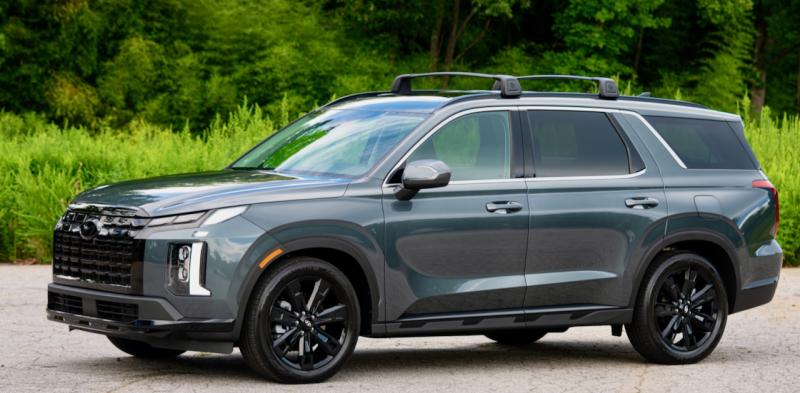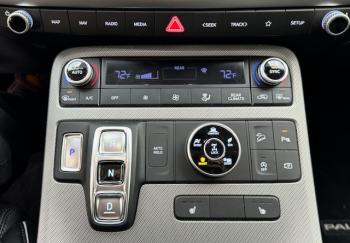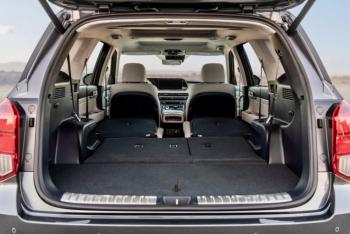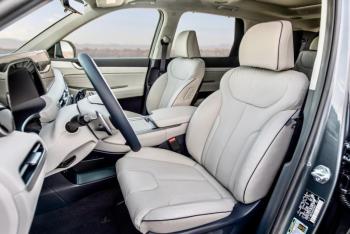Hyundai Palisade XRT AWD
Palisade: a fence of wooden stakes or iron railings fixed in the ground, forming an enclosure or defense (Oxford Languages); alternatively, an upscale three-row “family-first” crossover SUV from Korea available in six trim levels with a starting price of $36,650 plus shipping (Hyundai Motor Company).
It bears no resemblance whatsoever to a fence, and it is a smooth operator, the Palisade. Perhaps the name is meant to suggest protection from outside forces, and this the Palisade does well. Vehicles from Hyundai may have extra insulation sprayed into their body cavities; they are notably disturbance-free, and the Palisade especially so. Except for one niggle, which we’ll get to.
Even under a heavy foot, the 3.8-litre V-6 is barely audible, but its 291 horses propel this big wagon along with respectable verve. The 8-speed automatic transmission can be shifted manually via paddles behind the steering wheel, and a dial on the console lets the driver choose from among five operating modes: Smart, Sport, Comfort, Eco and Snow. Despite the fresh white stuff on the ground, I’ve been driving around in “Smart” because, well, who doesn’t want to be smart?
Comfort mode is the marshmallow setting; Sport sets everything on edge for quicker response, which seems uncouth in such a large barge; Snow has the opposite effect and Eco takes this a step further. Smart, however, is variable; it relies on an algorithm to quickly “learn” how I’m driving, and programs the electronically controlled transmission to follow suit. This isn‘t new—German and other cars have been doing it for decades—but it’s, you know, smart.
Save for the fact that the ignition button is hidden behind the wiper stalk, the layout (and function) of all the controls is notably simple and ergonomic. So much so that at first I thought this Palisade must be somewhat stripped down. No; the difference between our XRT and the three more costly trim levels are mostly luxury features and cosmetics; functionality is the same, including the larger touchscreen, built-in (as opposed to just smartphone-linked Apple CarPlay and Android Auto) navigation and Hyundai’s most sophisticated driver-assistance features.
These include the usual interactive cruise control plus braking, lane-keeping and lane-following assistance; blind-spot and rear-crossing alerts; parking proximity warnings and a multi-function rearview camera. Unusually, the lane-keeping features can be fully disabled for nanny-free driving. The Smartphone Generation needs a nudge once in a while to remind them to pay attention to the road, but we members of the Smarter Generation were trained to do this at an early age.
Front-wheel drive is the base setting across the Palisade line (except in the top trim, where AWD is standard), but our XRT is equipped not only with all-wheel drive, but also with an electronic locking center differential. All Palisades have trailer wiring, sway control and a transmission cooler installed; add the trailer hitch and 5,000 pounds of towing capacity is on tap.
As with last week’s Acura, I again failed to guesstimate the sticker price. The Palisade is so quiet, comfortable, elegant, well equipped and screwed, glued and welded together that I overshot the MSRP by a good 20 percent. With the freight & handling charge of $1,335 and $215 worth of floor mats, our XRT lists for $45,100, which feels like excellent value. (All I’d add would be a heated steering wheel and a retracting driver’s seat. Yes, I’m spoiled.)
It is of course possible to spend more on a Palisade: the increasingly swanky Limited, Calligraphy and Calligraphy Night versions list for $5,000 to $10,000 more. I wonder if they too whistle at highway speeds. This is the niggle I mentioned earlier—faint wind noise, which I assume comes from the tall roof rack.
Next week: Hyundai Kona N Line




























